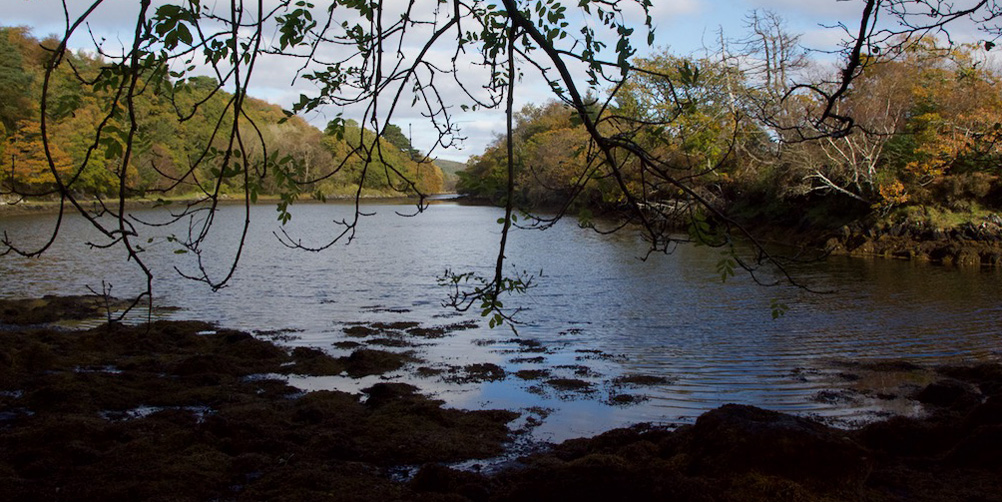
Finding the Faery Isles
On Friday we woke up to the first snow gleaming on the tops of Mull. Hail showers had been raking across in the night, rattling on the roof and sending fresh showers of beech mast onto the decking above Colin’s workshop. Today the peaks are still snow-white, topped up regularly by fast-moving squalls that bathe the islands for a few brief seconds in radiant golden light and then wrap them in a cold grey veil. Most of the elm and lime leaves have fallen – or been swept away – while the oak and hazel are clinging on.
It was last Sunday, on what was probably, with hindsight, the last day of autumn, that we decided to take a walk to the Faery Isles. The weather was calm and bright, with that mellow feeling that often comes in October. Just above Tayvallich we parked in the Forestry Commission car park for Loch Coille Bharr and set off down the woodland track, inhaling the scent of pine and keeping an eye open for fungi beneath the trees.
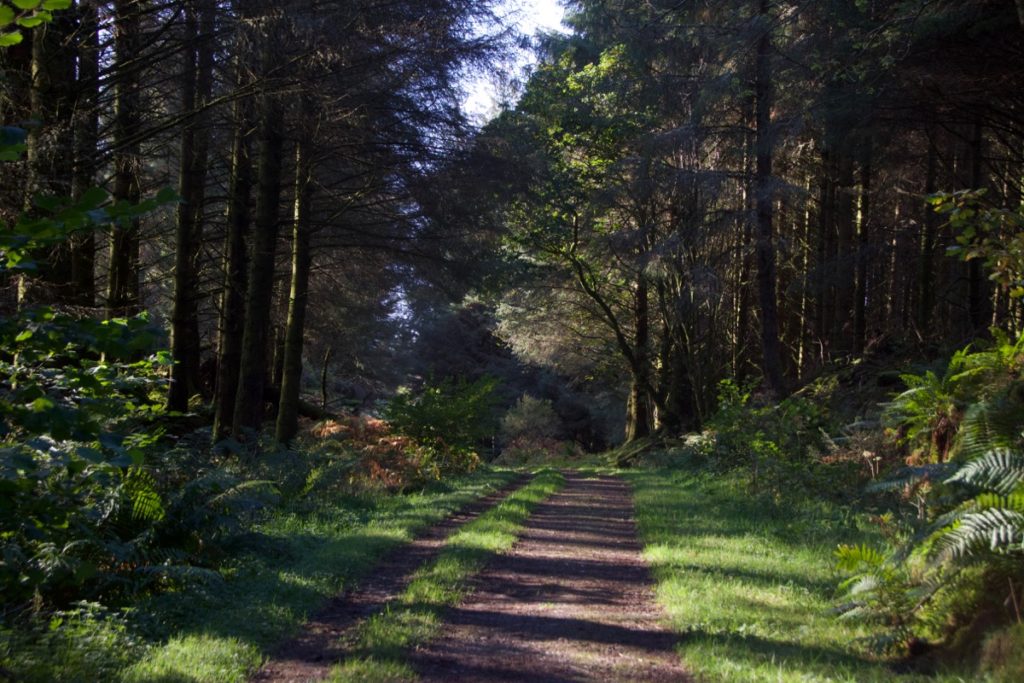 The Faery Isles are a group of small, uninhabited islands in Loch Sween, whose many ‘fingers’ reach far into the wooded slopes of Knapdale. Although they seem remote to us now, they must have been a familiar sight to the people who lived and farmed here until the mid-1800s. Getting to them means a long walk along a path that has probably seen many generations come and go.
The Faery Isles are a group of small, uninhabited islands in Loch Sween, whose many ‘fingers’ reach far into the wooded slopes of Knapdale. Although they seem remote to us now, they must have been a familiar sight to the people who lived and farmed here until the mid-1800s. Getting to them means a long walk along a path that has probably seen many generations come and go.
We stopped to look at the remains of Kilmory Oib, an abandoned village which I wrote about last year. Whenever we pass this way I have to go and visit the cross-marked stone that stands above the spring at the southern end of the village; I don’t really know why. I love peering down at the green waterweeds growing in the crystal-clear water, and wondering about the person – or people – who put the stone here. A little further on is Kilmory Mill – the ‘Dark Mill of Coilebar’ – whose wheel once ground the grain for a scattered community.
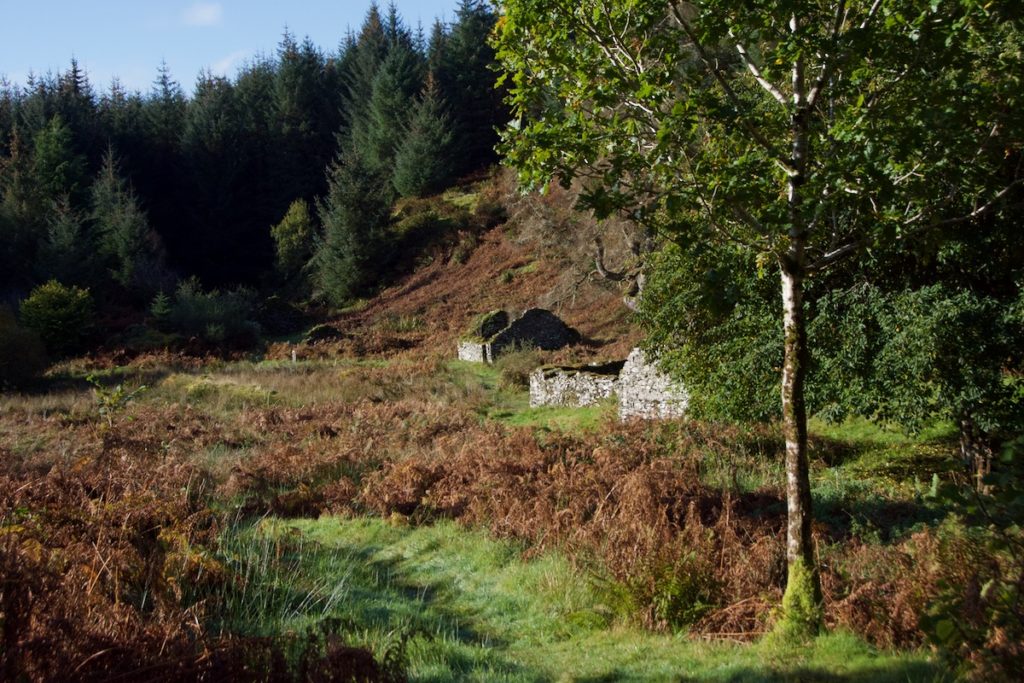
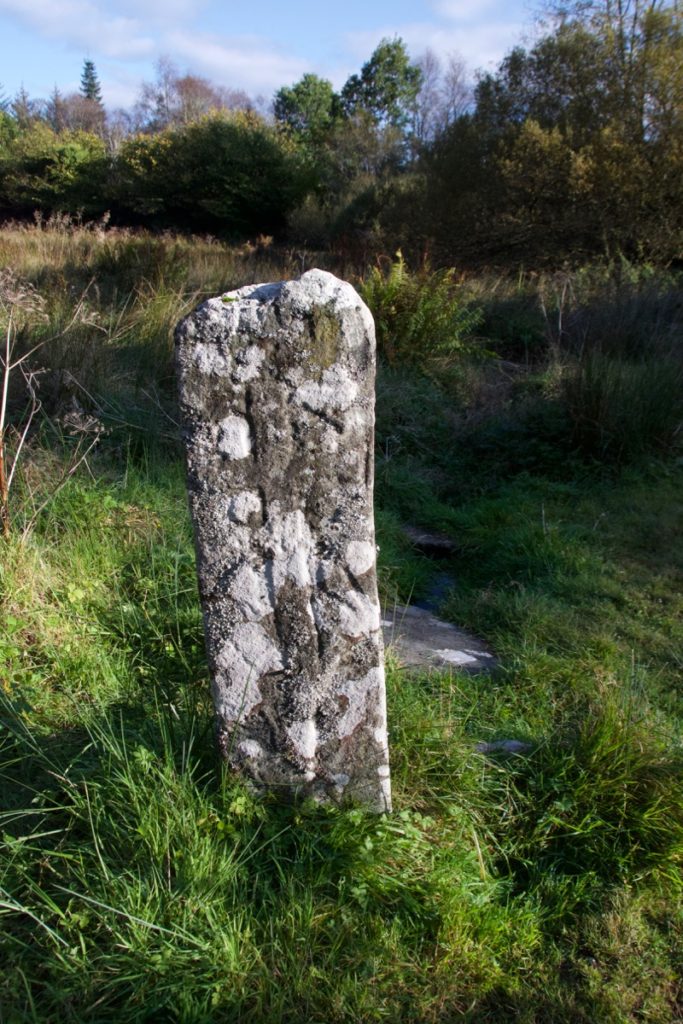
Above: Kilmory Oib and carved stone; below: Kilmory Mill
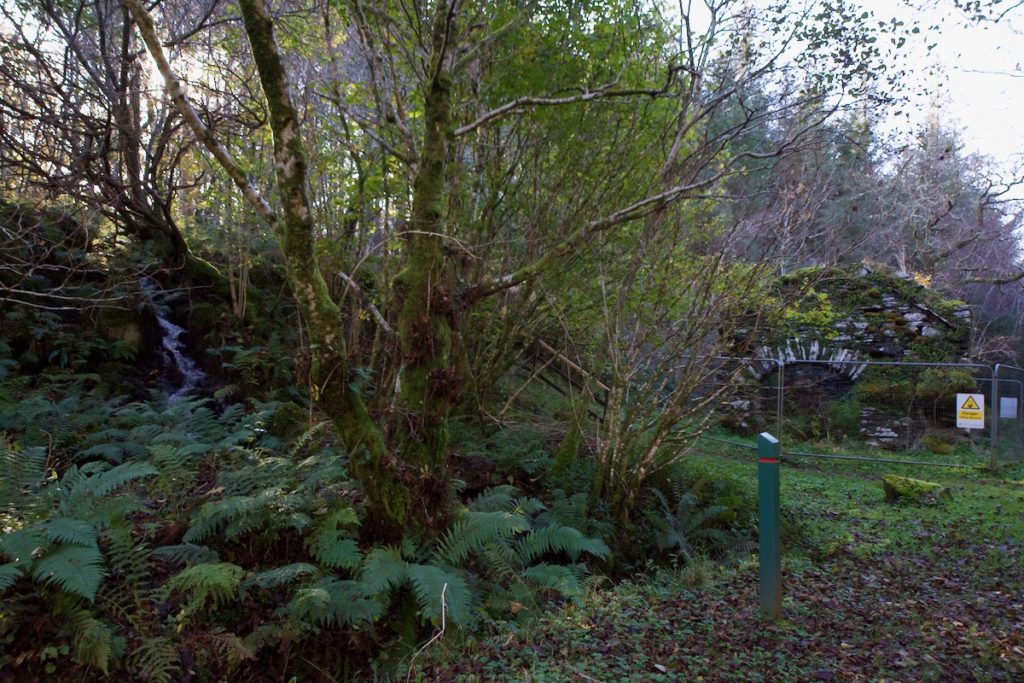 A fast-flowing burn runs parallel with the track before turning abruptly and falling, in a torrent of white spray, down to the valley floor about fifty feet below. The noise was both soothing and exhilarating, and we picked our way gingerly across fallen branches, thick with moss, in order to get a closer look.
A fast-flowing burn runs parallel with the track before turning abruptly and falling, in a torrent of white spray, down to the valley floor about fifty feet below. The noise was both soothing and exhilarating, and we picked our way gingerly across fallen branches, thick with moss, in order to get a closer look.
Some freshly-felled trees down in the ravine led Colin to suspect the work of beavers; they were reintroduced here ten years ago, and by all accounts they have been thriving. I’m not a fan of waist-high bracken, especially on a steep slope, but Colin launched himself down there in order to inspect their handiwork at close range. He was delighted to find plenty of beaver ‘spittings’ – I don’t really know what their by-products are called! – beautifully serrated curls of wood that had been gnawed from a tree trunk and discarded in neat piles beside the fallen tree.
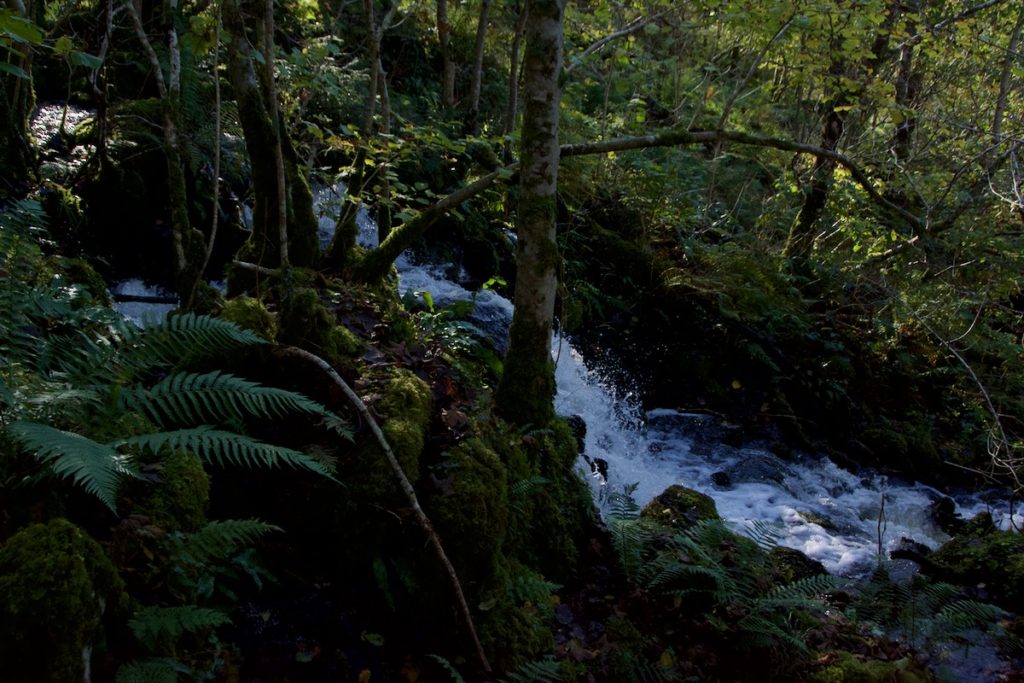
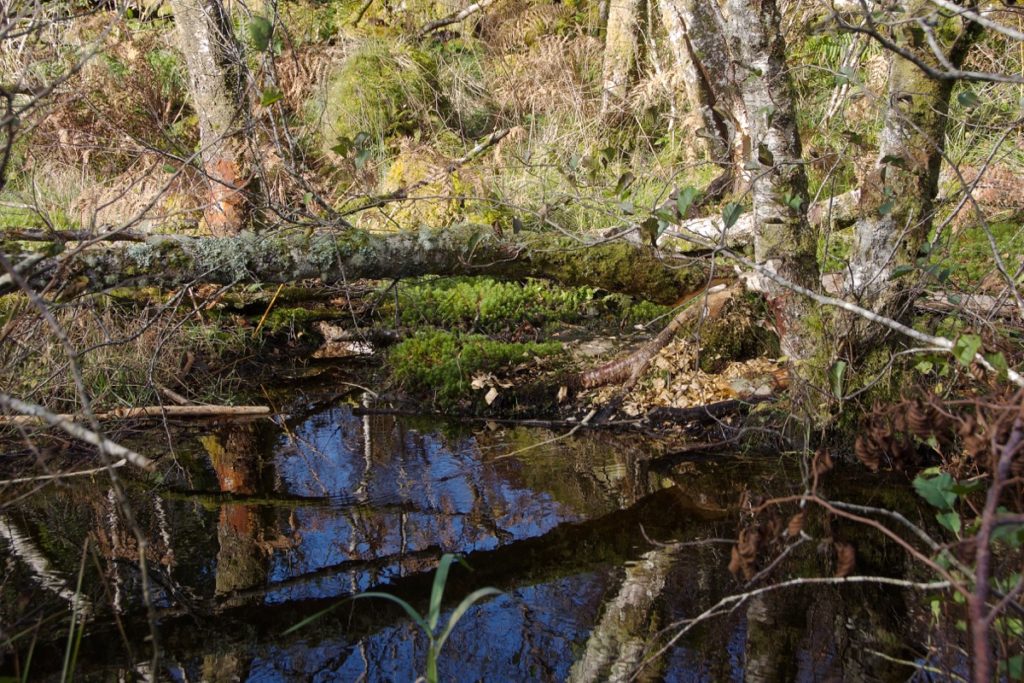
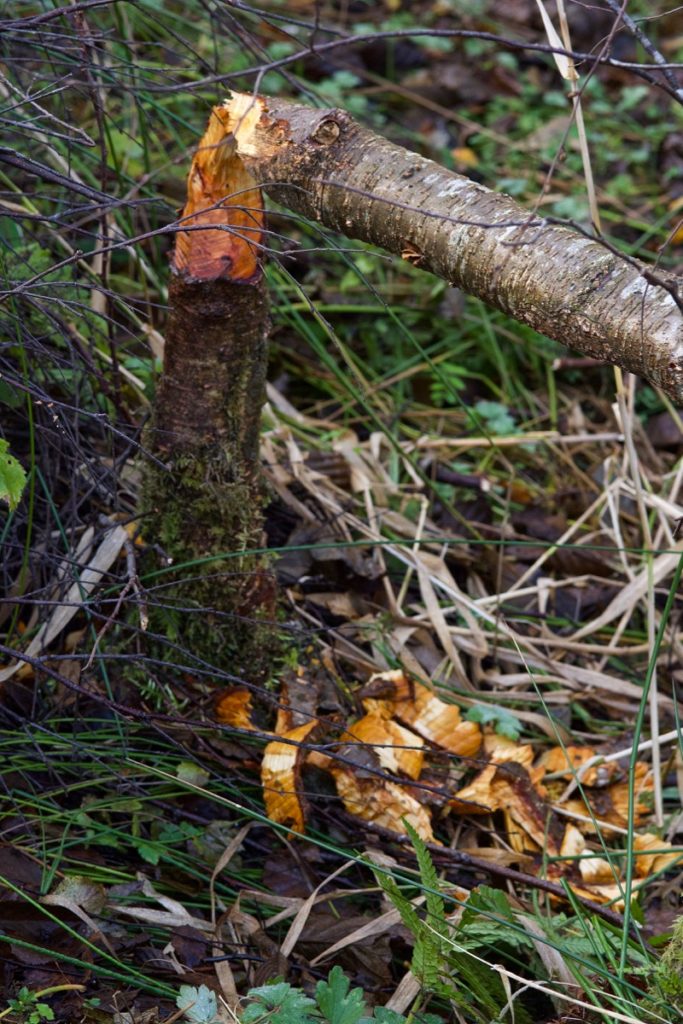 The path led us gradually downwards, across a larger burn that was full of peaty water after recent rain. Wayside trees included hazel and rowan, birch and alder, with stately specimens of oak and beech rising above them. We stopped to admire two or three magnificent willow trees whose leaves, now rapidly turning yellow, were whispering softly against a brilliant blue sky. Sometimes I think autumn is less of a season and more of a feeling – you can see and hear it, and you can even smell it, but you can’t grasp it. One sharp frost and those leaves will tumble silently in the darkness of the night, taking with them all the sunshine of summer.
The path led us gradually downwards, across a larger burn that was full of peaty water after recent rain. Wayside trees included hazel and rowan, birch and alder, with stately specimens of oak and beech rising above them. We stopped to admire two or three magnificent willow trees whose leaves, now rapidly turning yellow, were whispering softly against a brilliant blue sky. Sometimes I think autumn is less of a season and more of a feeling – you can see and hear it, and you can even smell it, but you can’t grasp it. One sharp frost and those leaves will tumble silently in the darkness of the night, taking with them all the sunshine of summer.
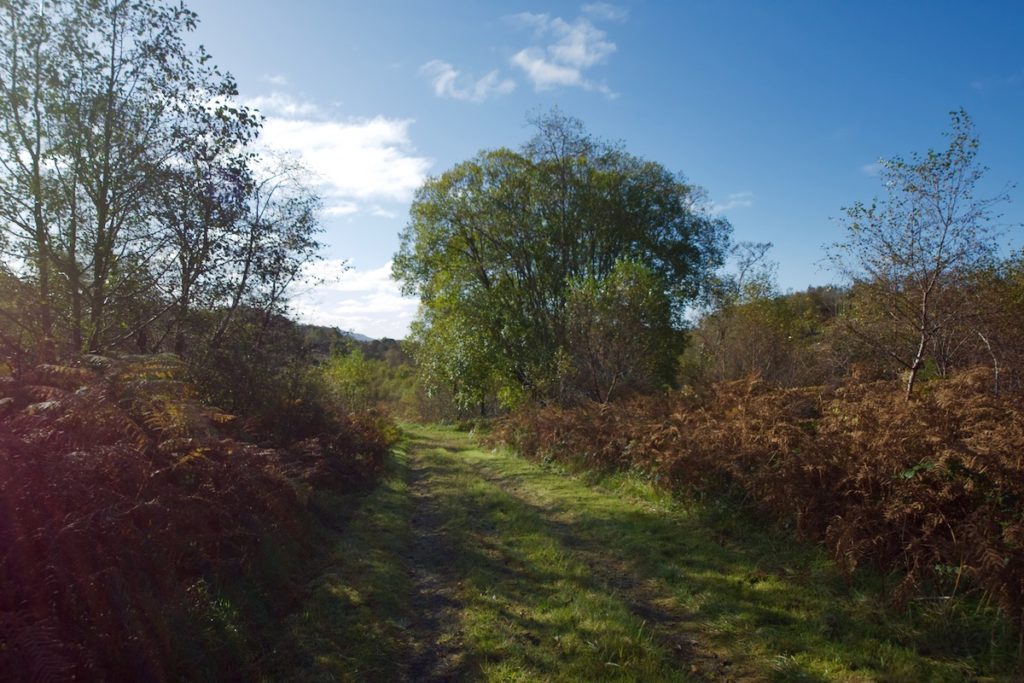
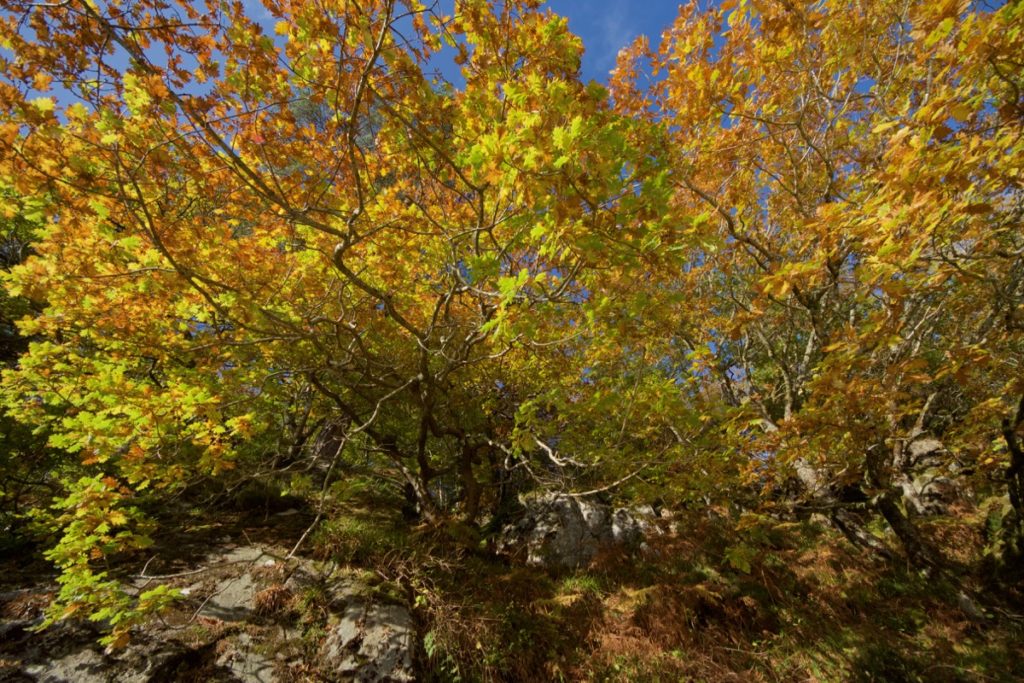
Oak (above) and willow (below)
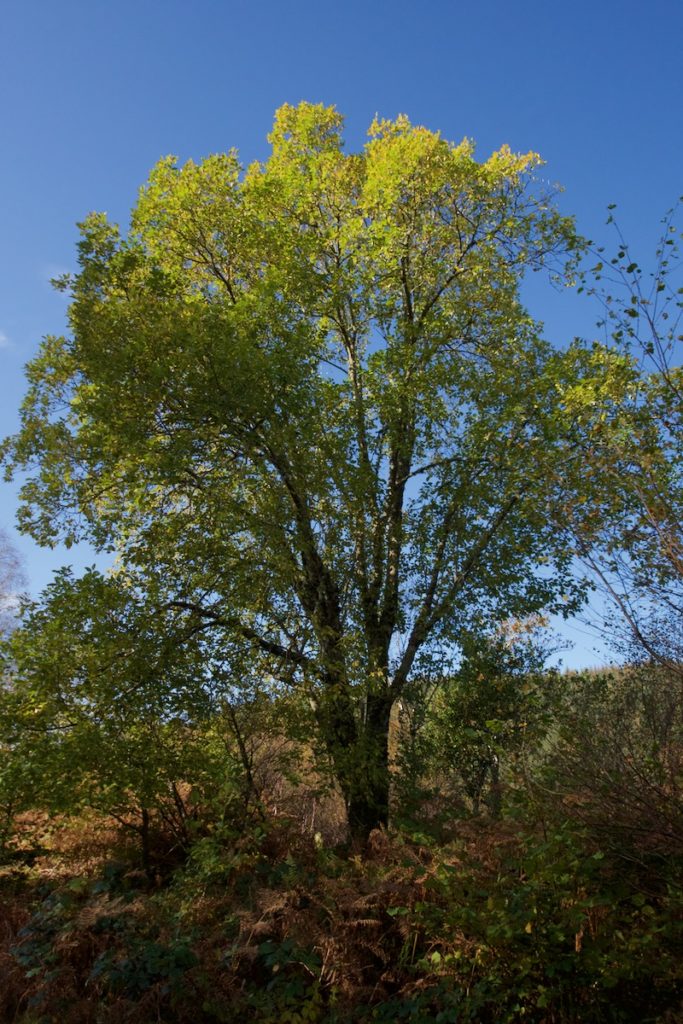
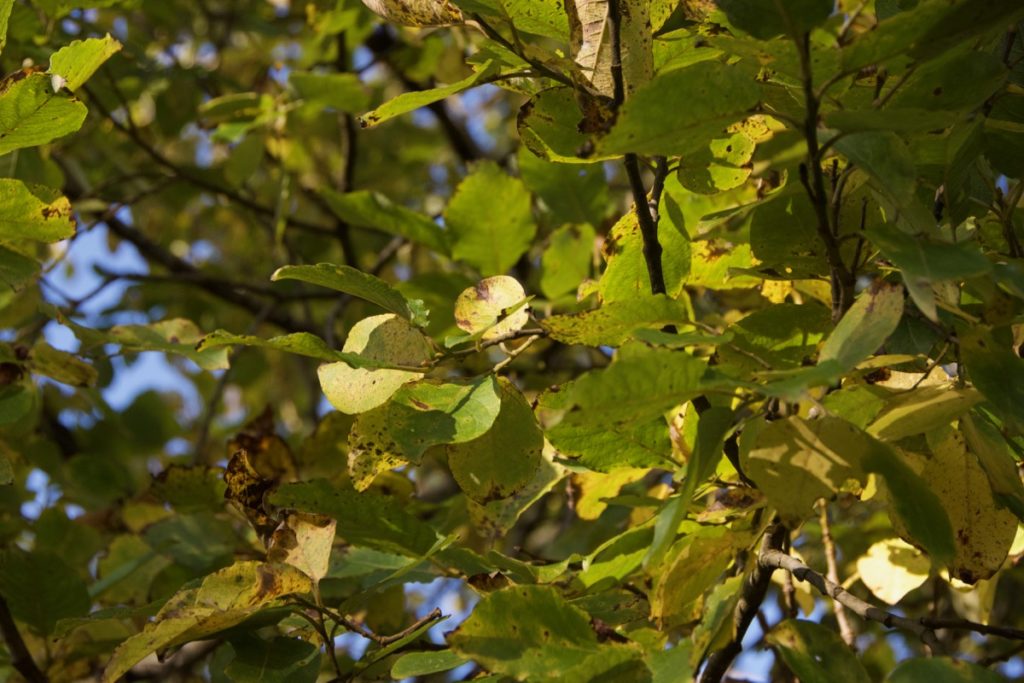 From looking at maps of the area, I was aware that somewhere along the path was an old burial ground that may have been used by the people of Kilmory Oib. We passed the remains of several buildings, now reduced to low walls and overgrown rubble, which seemed to suggest some kind of settlement or enclosure. We poked around for a while in the undergrowth, hoping for gravestones, but the bracken was still too thick to make out much on the ground. I’ve since realised that we may have been looking in the wrong place for the graveyard, which seems to lie further south, closer to the Faery Isles themselves. On old maps, a couple of buildings are marked here, with the name ‘Oibmore’.
From looking at maps of the area, I was aware that somewhere along the path was an old burial ground that may have been used by the people of Kilmory Oib. We passed the remains of several buildings, now reduced to low walls and overgrown rubble, which seemed to suggest some kind of settlement or enclosure. We poked around for a while in the undergrowth, hoping for gravestones, but the bracken was still too thick to make out much on the ground. I’ve since realised that we may have been looking in the wrong place for the graveyard, which seems to lie further south, closer to the Faery Isles themselves. On old maps, a couple of buildings are marked here, with the name ‘Oibmore’.
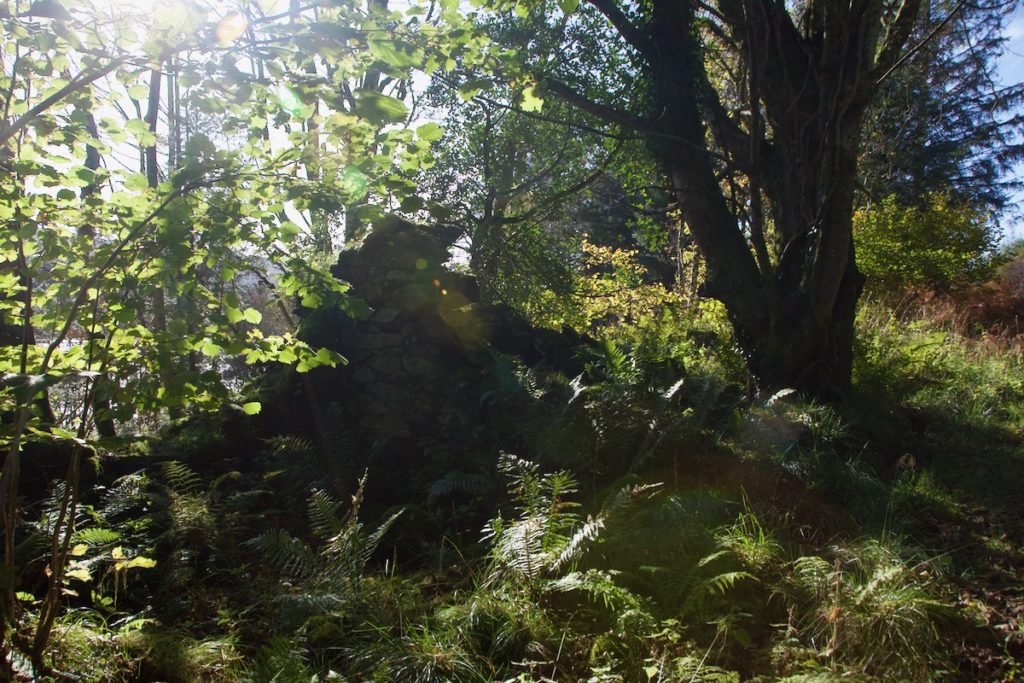
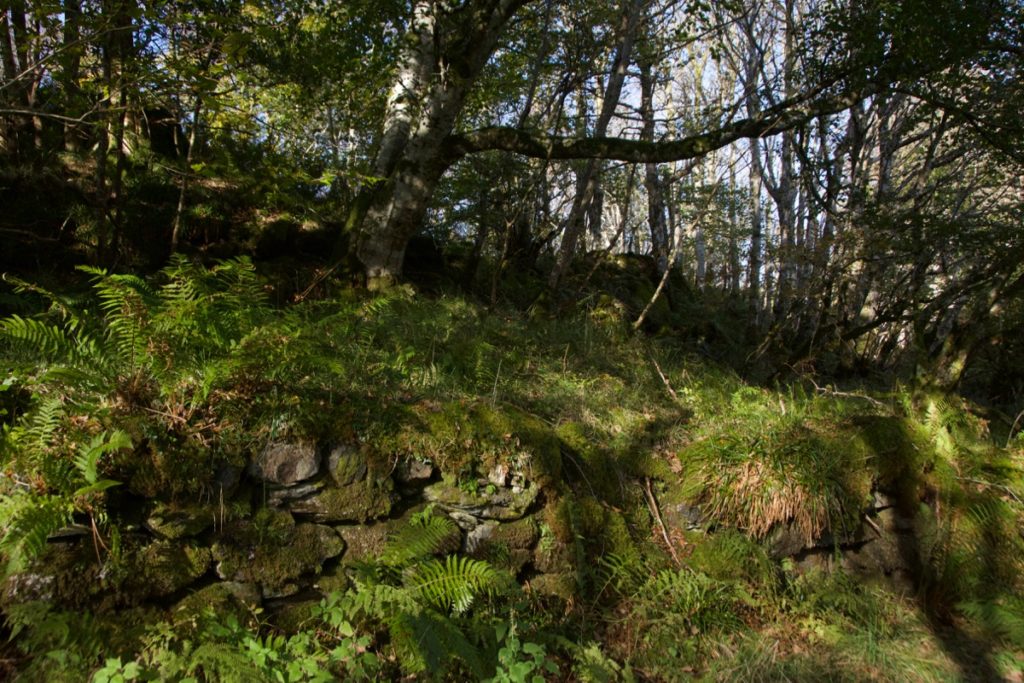
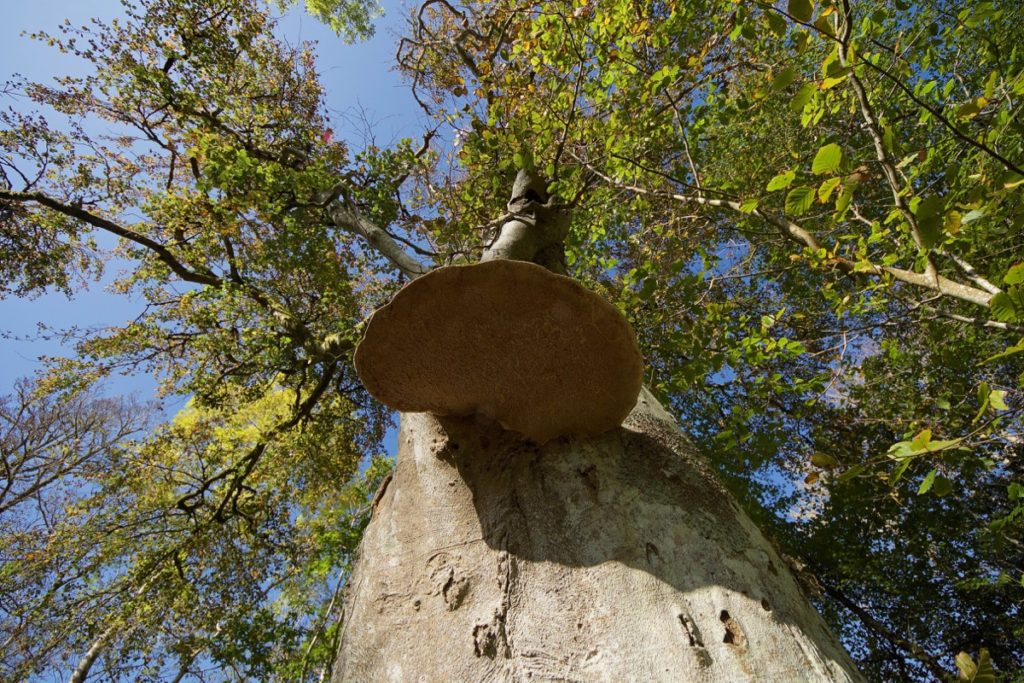 Above: A huge bracket fungus flourishing on the trunk of a beech tree. Below: amazing lichen!
Above: A huge bracket fungus flourishing on the trunk of a beech tree. Below: amazing lichen!
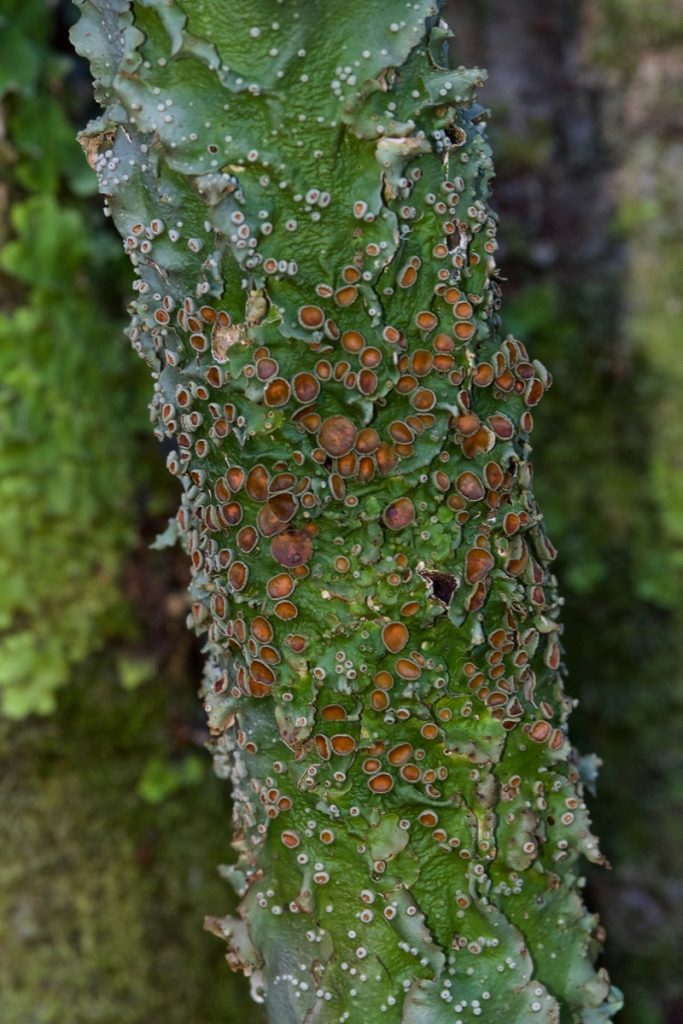 The last stretch of the walk takes you through a woodland which, according to the sign on the gate, is now populated with Highland cows in the old tradition of natural grazing. We didn’t encounter any of these hairy creatures, much to my disappointment. After about ten minutes of increasingly squelchy walking, we could see the sparkle of water through the trees, and the woodland opened out onto a rocky shore. A stone’s throw away, across a shallow tidal lagoon, lay Eilean a’Bhrein, one of the Faery Isles.
The last stretch of the walk takes you through a woodland which, according to the sign on the gate, is now populated with Highland cows in the old tradition of natural grazing. We didn’t encounter any of these hairy creatures, much to my disappointment. After about ten minutes of increasingly squelchy walking, we could see the sparkle of water through the trees, and the woodland opened out onto a rocky shore. A stone’s throw away, across a shallow tidal lagoon, lay Eilean a’Bhrein, one of the Faery Isles.
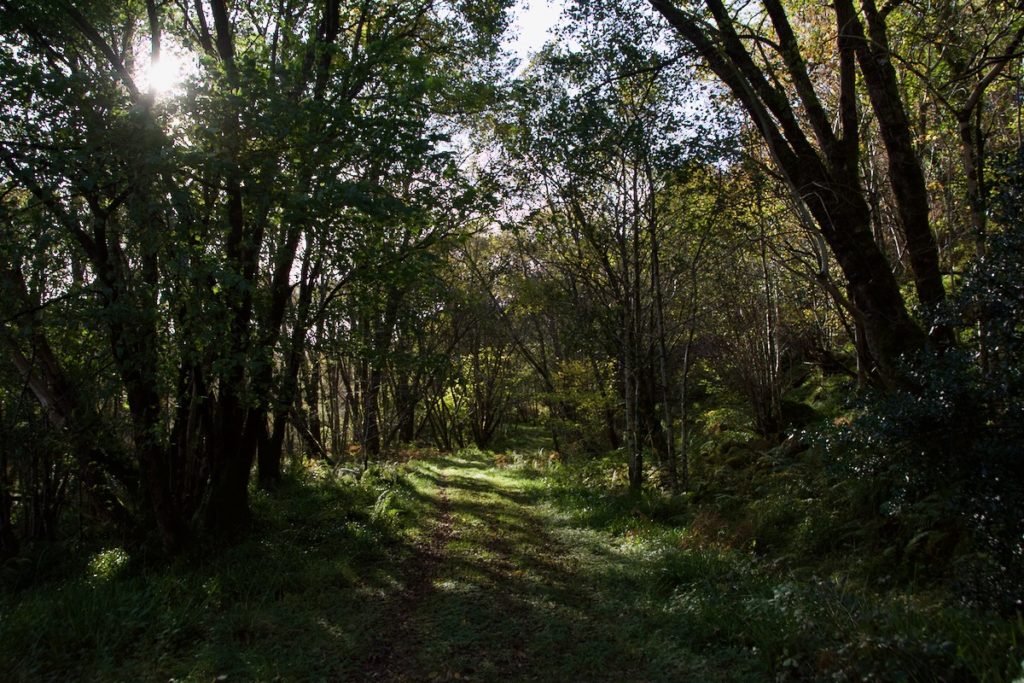
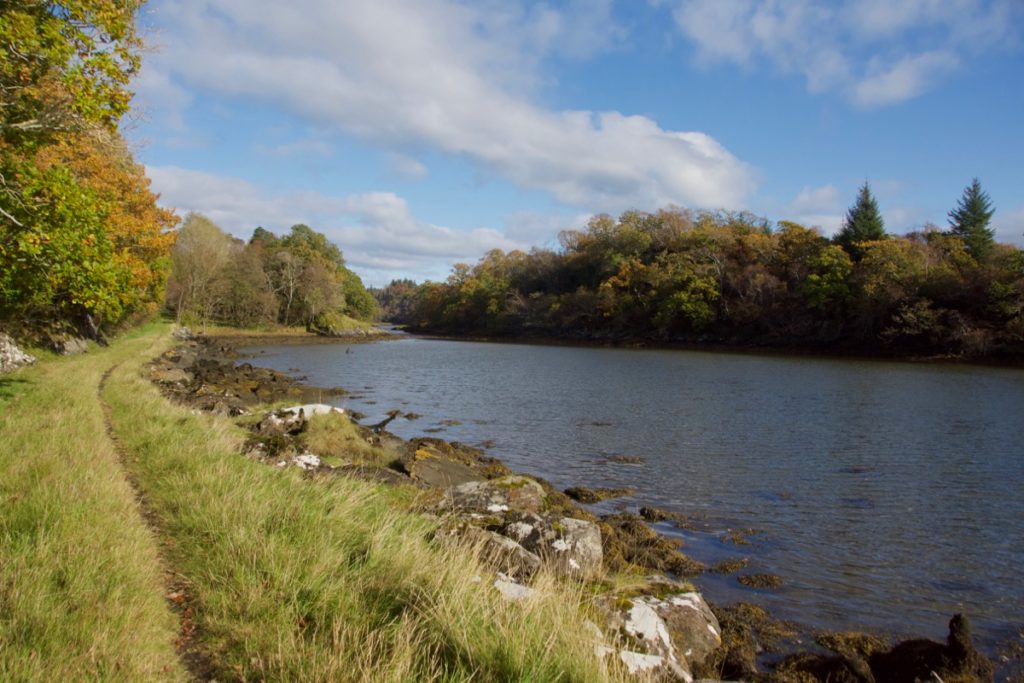
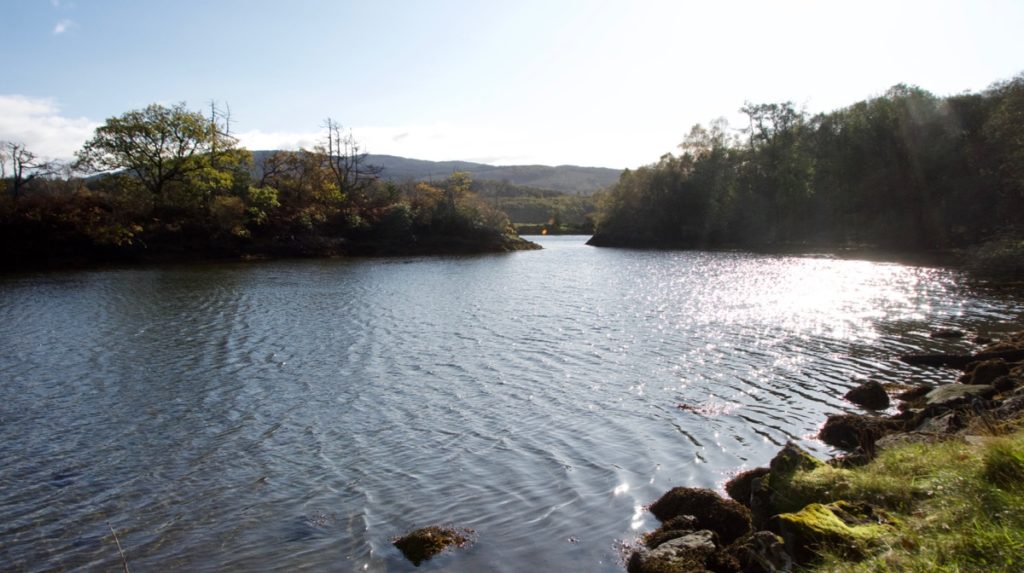 At first, I wasn’t even sure that it was an island, because the channels of water at either end are so narrow. The tide was low, and it felt as if you could wade across, although the mud is probably quite deep! We had a drink and basked for a while in the sunshine, enjoying the lap of the waves.
At first, I wasn’t even sure that it was an island, because the channels of water at either end are so narrow. The tide was low, and it felt as if you could wade across, although the mud is probably quite deep! We had a drink and basked for a while in the sunshine, enjoying the lap of the waves.
Overhanging the shore are some wonderful old trees, including oak, hazel and holly. To the south, the ground rises up slightly onto a promontory and we decided to climb up there in order to get a better view. Within five minutes I was reminded – for the hundredth time – that Scotland’s landscape can be at once rocky and boggy, which sounds like a contradiction until you actually push your way through the green tangle of this ‘temperate rainforest’. The impulse to stop and photograph lichens and fungi has to be weighed up against the risk of losing your feet into a softly engulfing bog.
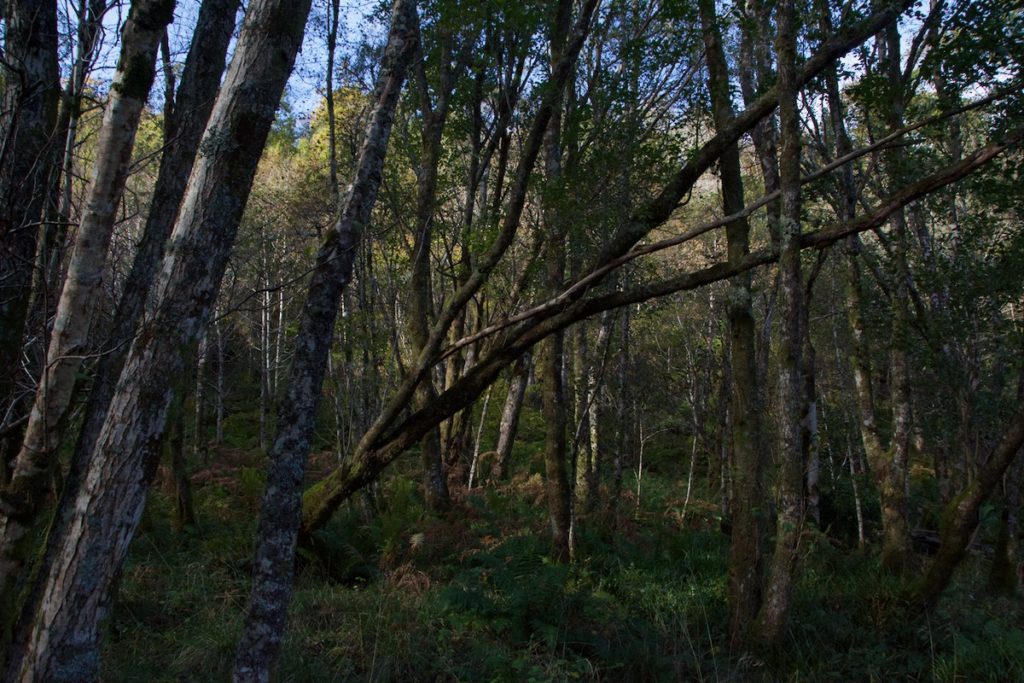
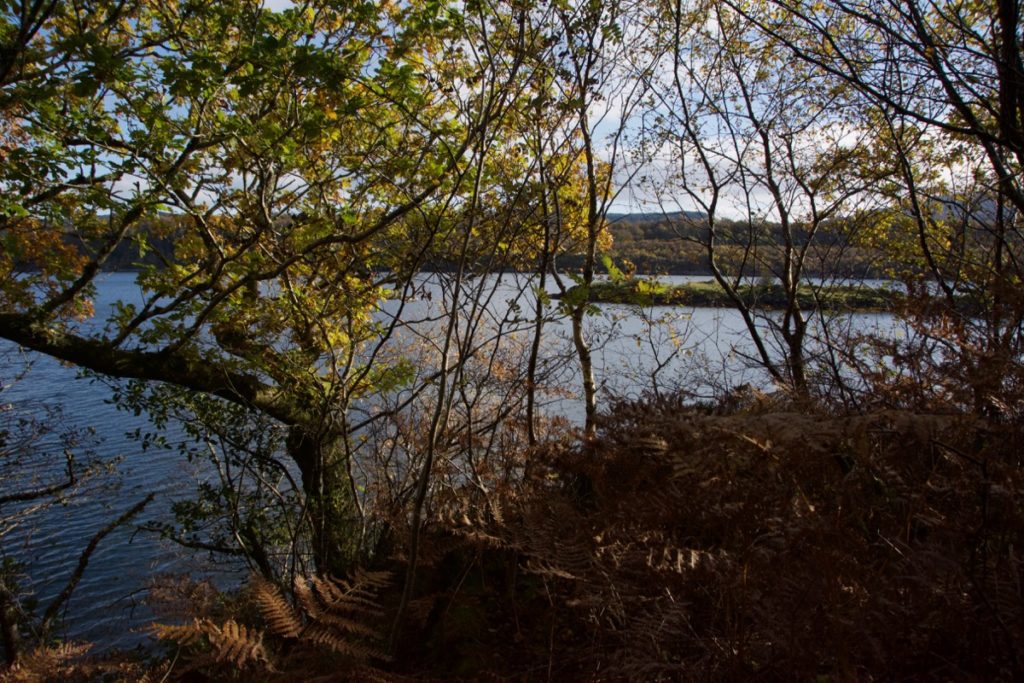
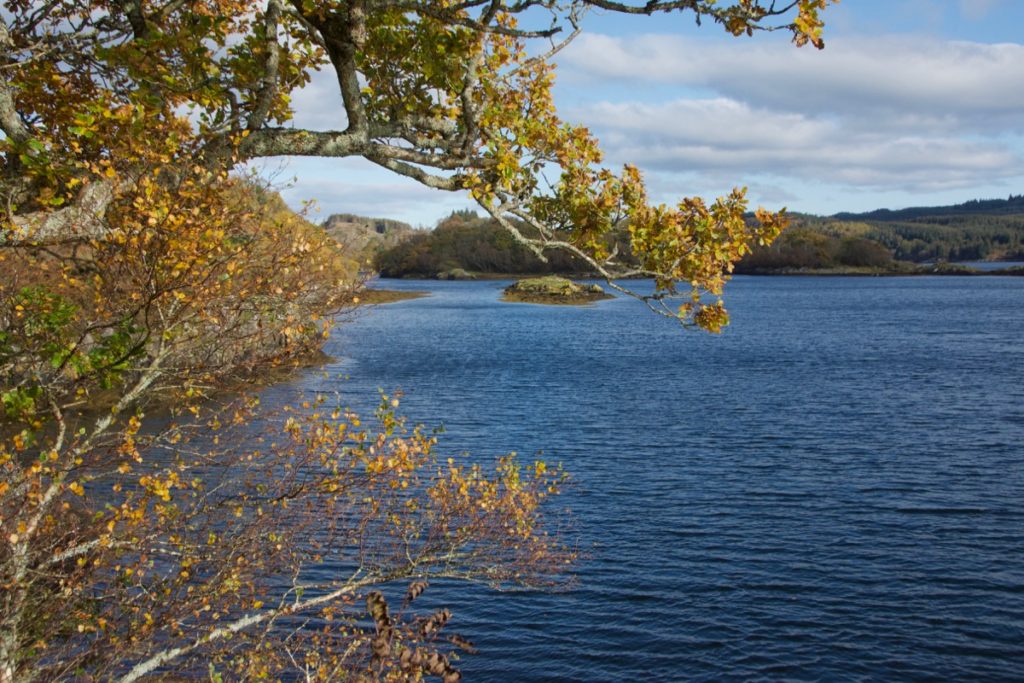
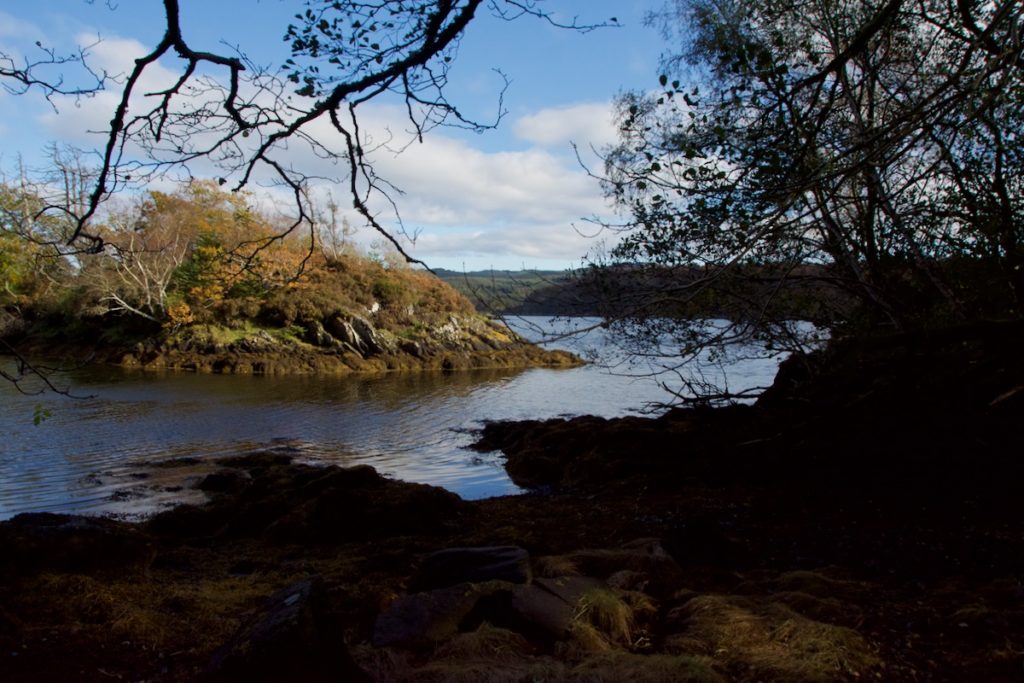
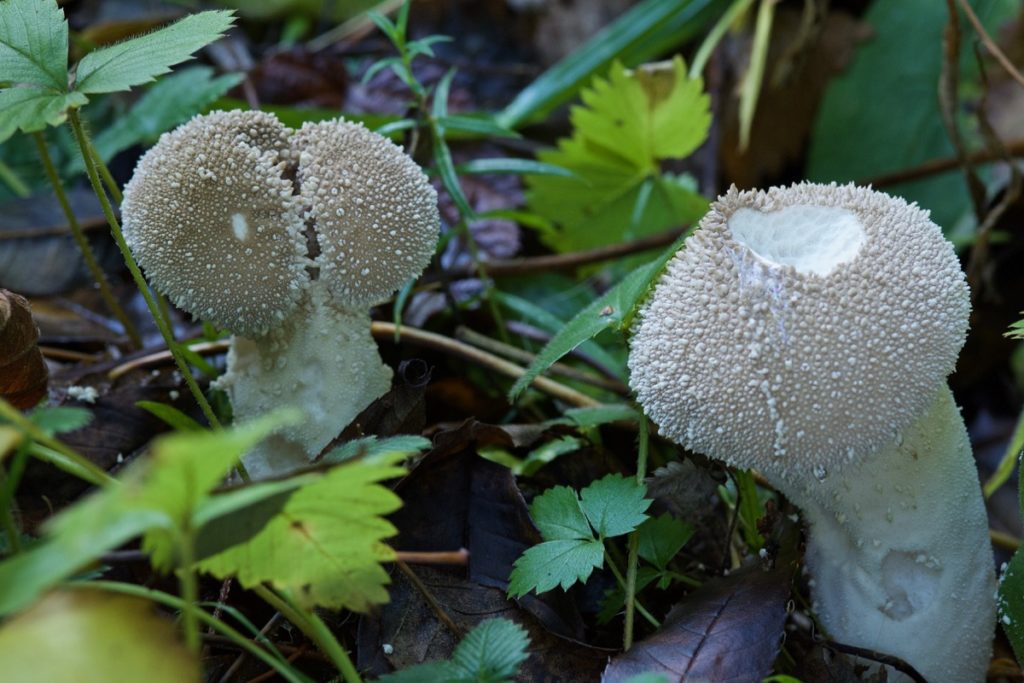
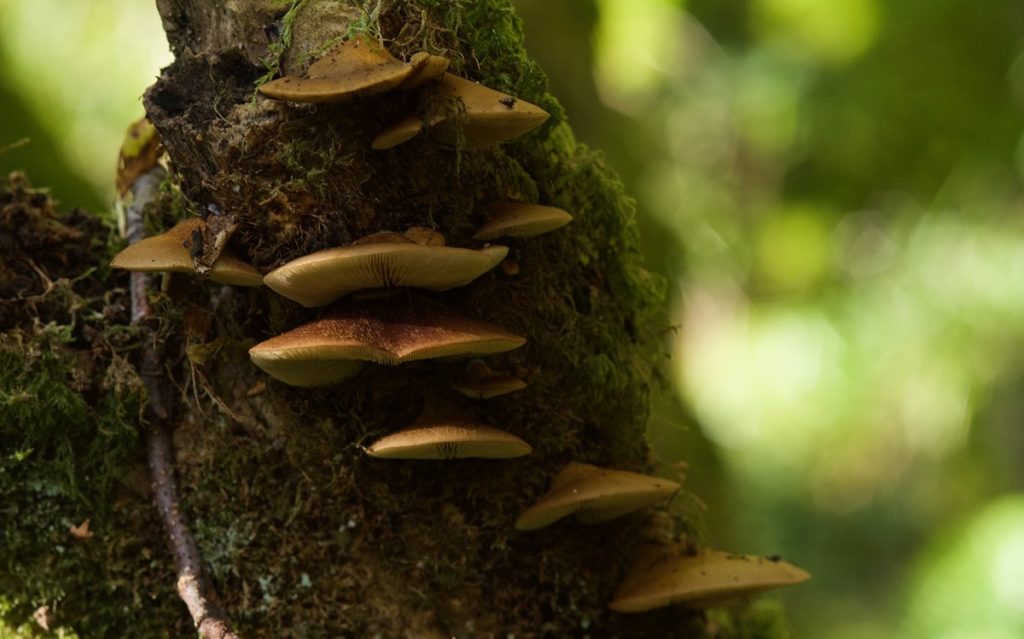
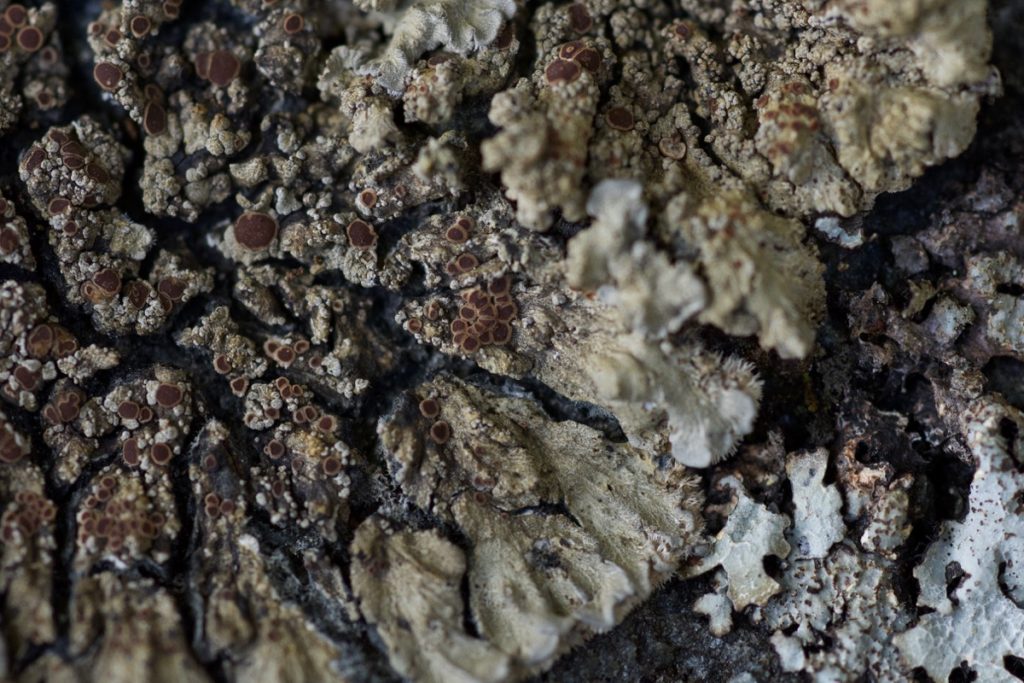
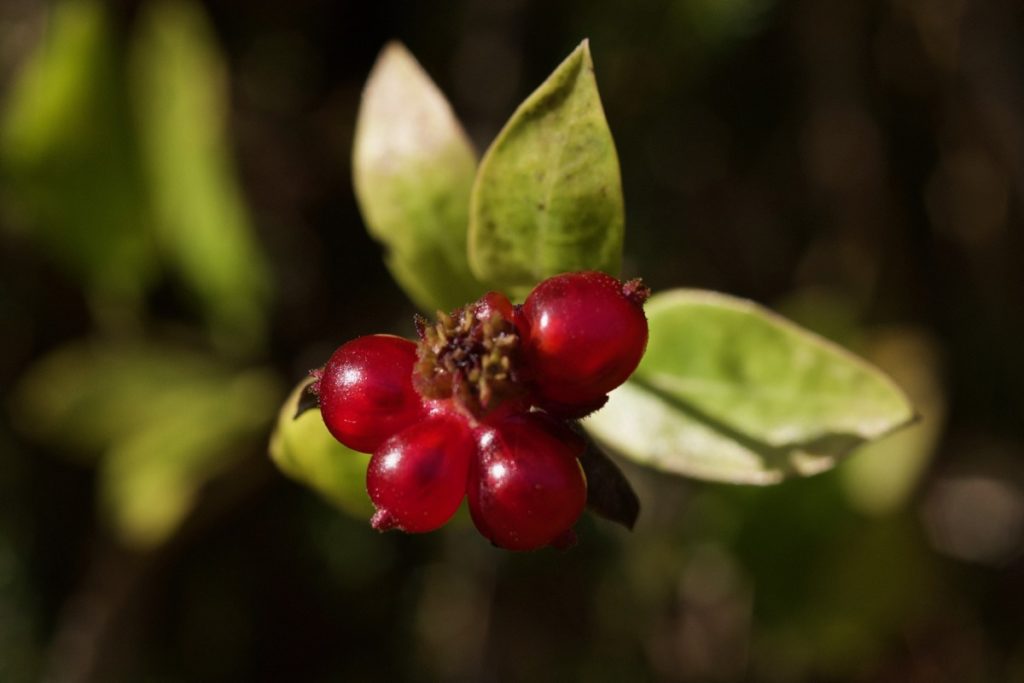 Honeysuckle berries
Honeysuckle berries
Why were they called the Faery Isles? I can’t help being curious. It’s interesting that there doesn’t seem to be a Gaelic equivalent on any maps, suggesting that the name may be comparatively recent. But still I thought I’d have a look. Browsing through a list of names on the Scotland’s Places website (compiled from documents dated 1868-78), I was intrigued to read that another place-name in Knapdale, Allt an Luaidh, “derives its name from the fairy opperation of fulling or thickening people’s cloth by the fairies Sign.” (In Gaelic, ‘luaidh’ means ‘waulking’ or fulling.) This led me to wonder if the Faery Isles were named because of a similar tradition, although there’s no evidence for that activity here. I wonder also what the fairies’ sign was – a rowan tree, perhaps?
Several sources describe the long-held belief that fairies were involved with the process of spinning, weaving and ‘waulking’ cloth. The Reverend Robert Kirk, a 17th century minister in Aberfoyle, Perthshire, claimed that he could perceive and commune with beings from the fairy world, and he had this to say about their industry:
“Ther Women are said to Spine very fine, to Dy, to Tossue, and Embroyder: but whither it is as manuall Operation of substantiall refined Stuffs, with apt and solid Instruments, or only curious Cob-webs, impalpable Rainbows, and a fantastic Imitation of the Actions of more terrestricall Mortalls, since it transcended all the Senses of the Seere to discerne whither, I leave to conjecture as I found it.”
‘The Secret Commonwealth of Elves, Fauns and Fairies’
There’s another answer entirely, of course, which owes nothing to folk history or etymology. If you accept that fairies, or any kind of ‘supernatural’ energies exist, you don’t need to go seeking explanations! It’s delightful enough that they are there. And it has to be said that the islands and the loch do hold their own quiet sense of enchantment. The journey there was perhaps as important as the place itself: do we step into these otherworldly places, or do we carry that perception with us? As robins poured out their wistful autumn songs, we sat for a while and looked and wondered; and then, with the best of the daylight behind us, we started to wend our way back towards Loch Coille Bharr.
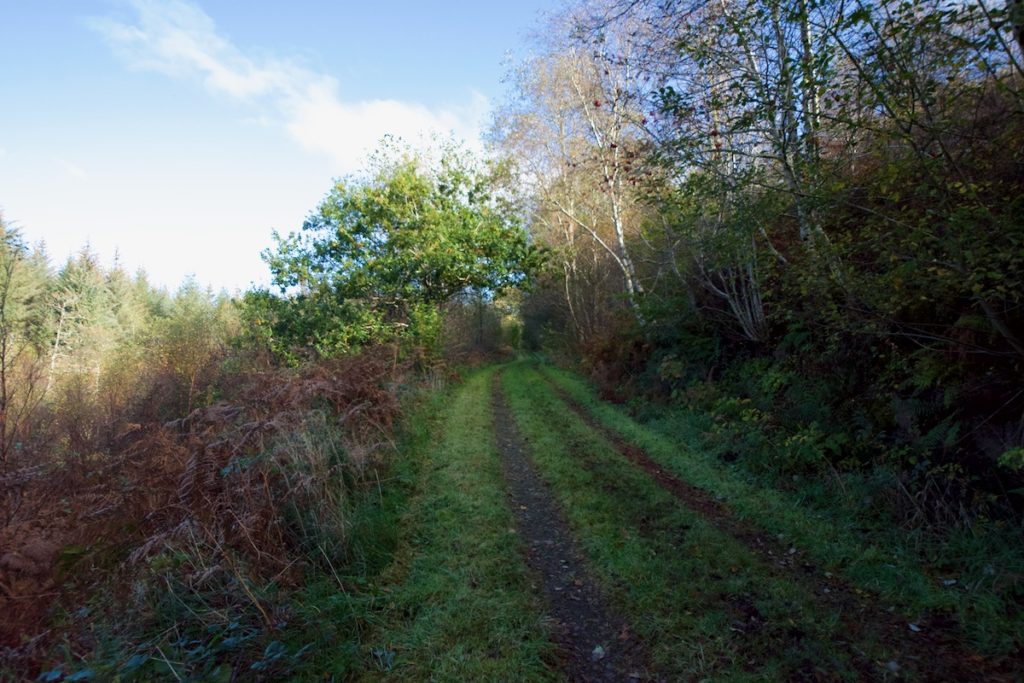
Notes:
On some old maps, sculptured stones are marked, high in the woodland on the shore facing the Faery Isles. This is a pretty steep slope and I’m not sure what our success rate would have been, even if we’d known!
’Waulking’ (in Gaelic, ‘luaidh’) is another word for fulling, a process of soaking and pounding newly-woven wool with the hands or feet in order to thicken and soften it. Traditionally, the wool was soaked in stale urine and the work was done by several women, working together at a board and singing ‘waulking songs’, many of which survive.
Reference:
- Scotland’s Places (Argyll vol.27)
- Forestry and Land Scotland
- Scottish Wildlife Trust (Knapdale Forest)
- ‘The Secret Commonwealth of Elves, Fauns and Fairies’ by Robert Kirk (1644-1692), pub. 1815
Images copyright © Colin & Jo Woolf
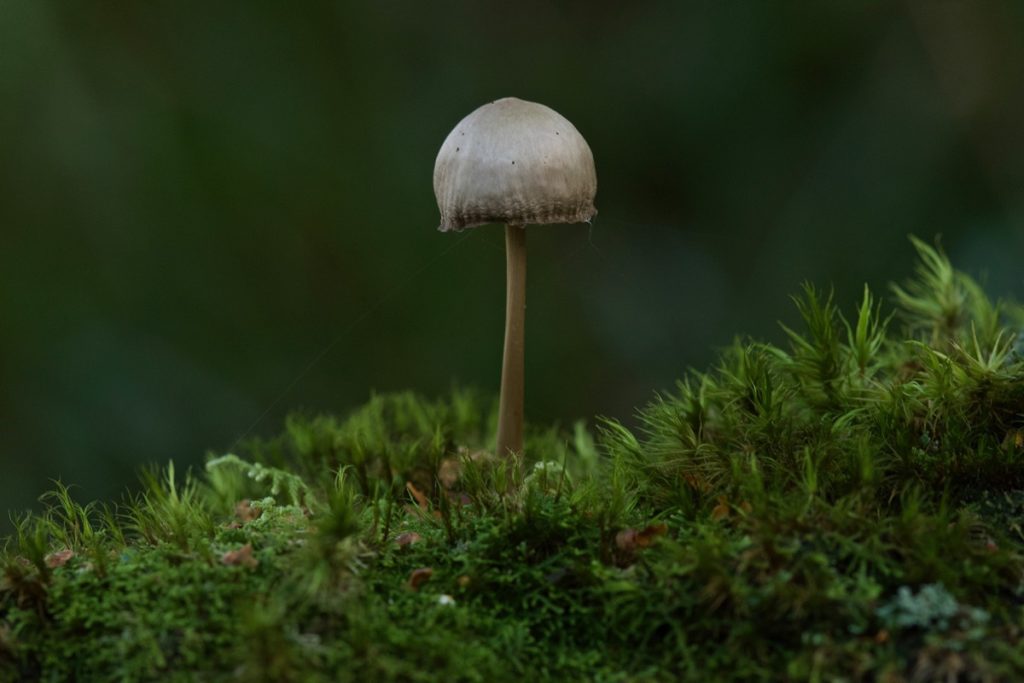

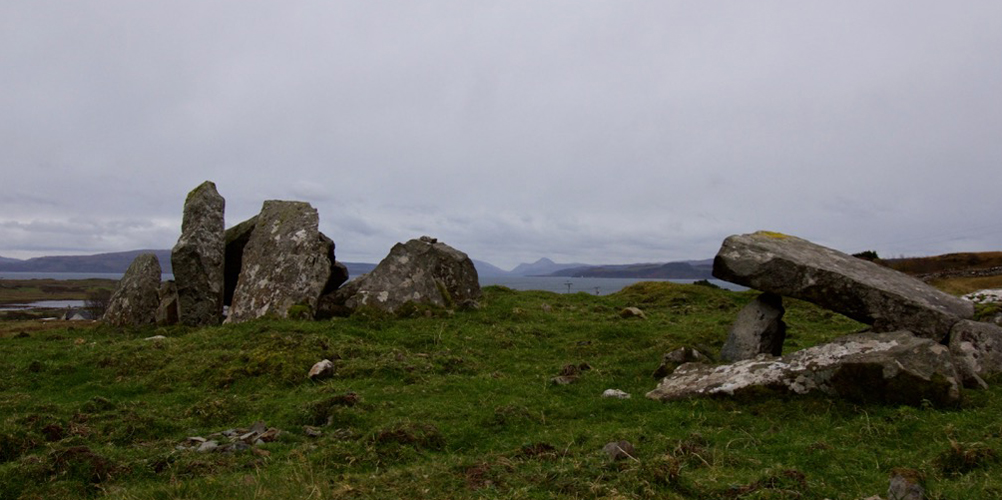
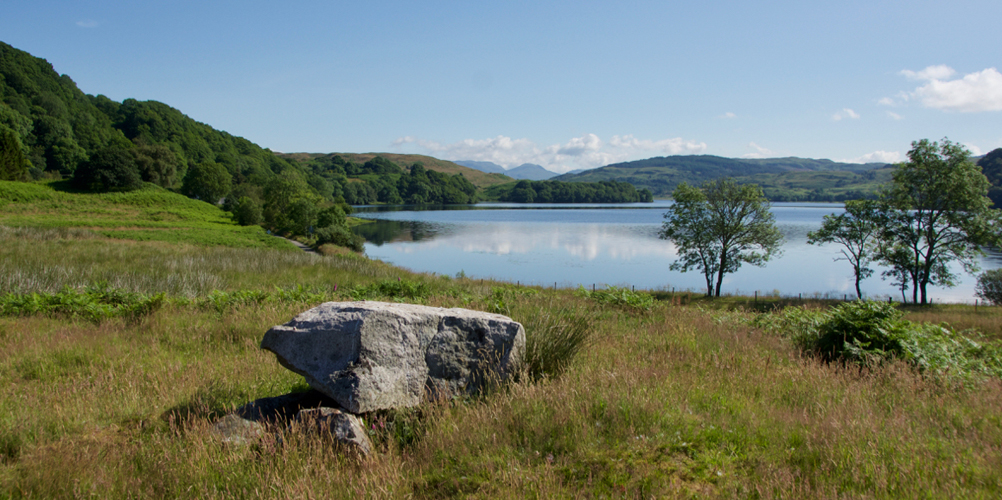
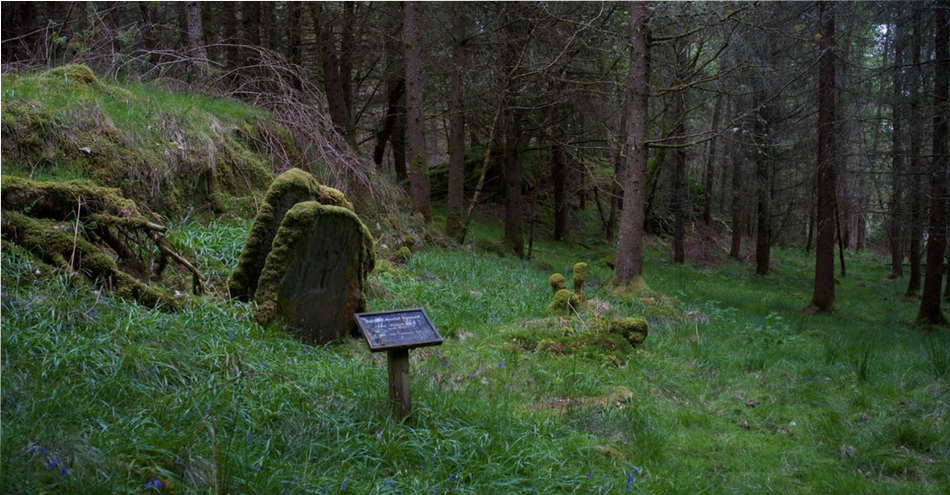
16 Comments
Gail
I love your blogs, they never fail to be interesting and absorbing, and the photos are always glorious too. Thank you.
Jo Woolf
That’s lovely, Gail, thank you! Really glad you enjoyed it. We loved exploring this amazing place!
Elaine
I am a long time admirer of your work I cannot wait to read your adventures. Thank you so much ?a fellow wanderer
Jo Woolf
Thank you so much, Elaine! You’re very kind – and a fellow wanderer too! I love finding these out-of-the-way places, and I especially love this part of Knapdale.
Diane Blackwell
Thank you for that, it is quite incredible to be transported to Scotland in this way!
Jo Woolf
Awww, glad you enjoyed your ‘visit’! Thanks, Diane!
Ashley
Wonderful Jo! I would agree that this visit must have been enchanting! You use the word yourself and it is appropriate to your post! Friday (25th Oct) was our first day of really heavy frost in Northern Ireland, but no snow, well none that I could see on the very low lying land around here (River Bann, upper). The photographs are lovely!
Jo Woolf
Thank you, Ashley! It was a lovely walk, and we might find ourselves back that way again because it’s so beautiful. I’m hoping for some more frosty mornings as they’re great for photography! I’ve got a list of places to visit in winter conditions.
Darlene
Lovely post. And your photographs are particularly beautiful.
Jo Woolf
Thank you, Darlene! We did have fun taking pics! Perfect conditions for it that day.
Finola
What a lovely post – enjoyed it so much. The lichens and fungi are pretty spectacular. Fulling must have been a horrible occupation, made marginally less so by the songs and camaraderie.
Jo Woolf
Thank you, Finola! That’s lovely. Yes, there were just so many lichens and fungi, impossible to include them all! Yes, I’m very glad I don’t have to do any fulling, although it sounds as if the ladies made the best of it! I wonder how and why it was discovered that urine was beneficial in the first place!
davidoakesimages
Another great tramp thru some ‘wildish’ countryside…. enjoyed the read….. BUT you will have to see if you can get close to the elusive Beavers! That would be a real treat 🙂
Jo Woolf
Thanks, David! Yes, no doubt we’ll encounter them at some stage! Would be good! 🙂
Robert Turner
Great stuff again Jo. Thank you.
Jo Woolf
Thank you, Bob! Glad to hear you enjoyed it.